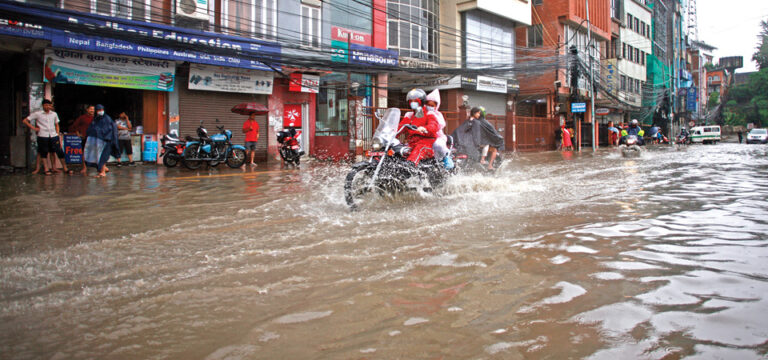
Every monsoon, several places of the Kathmandu Valley get submerged due to rise in water level in the rivers and a poor drainage system in which the flow of water is often obstructed.
Over the years, the valley’s urban structure has developed exponentially but its poor planning has led many places to face havoc during the monsoon.
As per urban planning experts, the settlements nearby the rivers of the valley are always at risk of flood and have their properties submerged when the water level in those rivers increases unexpectedly.
A report by the ‘Nepal Landless Democratic Union Party’, which advocates for squatters, shows there are over 8,000 families living along the Bagmati riverbanks alone.
Similarly, there are more than 29,000 landless people in the Kathmandu Valley living in 73 settlements; 80 per cent of total squatters live on the riverbanks in Kathmandu, Bhaktapur and Lalitpur districts.
Balkhu River inundated many houses during the monsoon of 2018 and 2019 followed by flooding in various parts of Bhaktapur as Hanumante River burst its banks.
With the weather departments informing about heavy rainfall during this monsoon, the valley rivers are likely to wreak havoc on the settlements of the riverbanks this year as well.
“The rivers had their own course which got congested with the development of Kathmandu and river embankments. During monsoon, the rivers make us pay for our mistakes because flood is natural in rivers,” said Kishore Thapa, a former government secretary and an urban planning expert.
However, it is not only the riverbank settlements that are in danger. The poor drainage system in the Valley has always been the main reason behind flooding in several areas away from the rivers.
The New Plaza, Putalisadak and Anamnagar area were submerged in water on Saturday when the drainage failed to bear the pressure of water flow following a heavy rain.
Pedestrians along with vehicles faced difficulties on the roads and the water entered in some shops and houses as well.
“The drainage systems in the valley are not adequate to allow proper flow of sewage and rain water during monsoon which causes overflow of water on the roads causing inundation, which has been a major problem in Kathmandu for long,” said Thapa.
Experts suggest that the authorities should increase the capacity of drainage because climate conditions show chances of unprecedented rainfall every year. Similarly, the public have also been requested to not pollute the city as plastics and other wastes block the drainage.
“Bigger drainage systems have been constructed in some places but they are connected with small ones at the end. The drainage system across the Valley should be upgraded if authorities truly want to mitigate submerging incidents in the valley,” Thapa told The Rising Nepal.
Likewise, authorities have also been suggested to conduct regular maintenance of the drainage system to ensure that it hasn’t been blocked by wastes.
When contacted, the local levels informed that they were taking necessary steps to tackle the incidents of inundation.
“Maintenance of drainage takes place timely and required upgrading is also done when needed. Ward levels also conduct necessary study of the monsoon effects in their area and propose necessary plans and policies to tackle it,” said Ishwor Man Dangol, spokesperson for Kathmandu Metropolitan City.
Similarly, Dangol also informed that disaster management committee under the metropolis was undertaking a study to introduce Early Warning System for the riverbank settlements about flood in the rivers.
Source : TRN, Photo : TRN,






